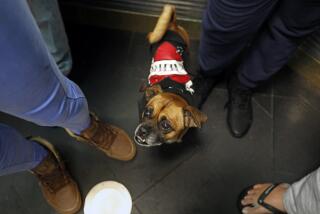All for the love of a dog
- Share via
WEST HEBRON, N.Y. — From the broad porch of his 200-year-old farmhouse, author Jon Katz gazed over an idyllic scene of hills and valley, one border collie lolling at his feet and two others pacing restlessly nearby.
“A lot of people tell me I’m living their fantasy life,” Katz said. “There are a lot of frustrated, alienated people who just aren’t doing what they want. I think that’s sad.”
Katz has done what many frazzled urbanites can only dream of doing: He chucked a spirit-sapping life in suburban New Jersey, bought a picturesque farm and an assortment of amiable animals and started a new life where the air is sweet and the stars shine bright far from the city lights.
Most people need a catalyst to provoke such dramatic change. For some, it’s a divorce. For others, a brush with life-threatening illness. For Katz, it was a maniacal dog named Orson.
In his new book, “A Good Dog: The Story of Orson,” Katz chronicles the life and death of the lovable but troubled border collie that transformed his life. It continues the story begun in Katz’s last book, “A Dog Year,” now being made into a movie starring Jeff Bridges as Katz.
Katz refers to Orson as his “lifetime dog.” It’s a term that many dog lovers understand.
“Lifetime dogs intersect with our lives with particular impact; they’re dogs we love in especially powerful, sometimes inexplicable, ways,” he writes in “A Good Dog.”
Orson was a well-bred, handsome dog with keen intelligence and a wily nature. He came to Katz when he was 3, bringing the sort of mischief that lands dogs in the pound: escaping from the yard, chasing school buses, nipping kids, stealing food.
“He was very loving, very beautiful, very affectionate,” Katz said, sitting on his porch before a book signing at a nearby country store. “He watched out for me, hung around with me. But he had a broken part to him.”
Orson’s arrival five years ago provided the impetus Katz needed to reinvent his life. At the time, he was living in New Jersey in a house with a white picket fence and two civilized Labrador retrievers. He worked at home as a writer.
A comfortable life, but not fulfilling. Katz’s beloved daughter had gone off to college. He had a lot of acquaintances but few close friends. He craved change.
“I believed that before that death when the body gives out for one reason or another, there was another, more insidious one -- the death of your sense of possibilities, a rusting of the hinges and closing of the doors inside your mind. That was the one I most feared,” Katz writes.
His attempts to deal with Orson’s problems led Katz to buy a 110-acre farm on a steep hillside in upstate New York, near the Vermont border, 180 miles north of New York City. He also acquired two more border collies, some sheep for them to herd, donkeys to guard the sheep from coyotes, a gimpy rooster, three hens and a barn cat.
He now writes about dogs and rural life from the place he named Bedlam Farm. He has written five books about dogs and has two more in the works.
“Jon’s writing reflects the way he is as a human being -- sensitive, smart, funny, perceptive and generous beyond imagination,” said Liz Manne, producer of “A Dog Year” for HBO Films. The nurturing instinct that drove Katz to go to extraordinary lengths to help Orson was apparent in the way he graciously took care of everyone involved in the filming that turned his rural peace into chaos, Manne said.
Life on the farm is rewarding but often hard, Katz said. “Winter can be brutal. My first winter here, lambing in February, I got frostbite and lost four or five ewes and four or five lambs. There’s always something going wrong -- a broken fence, mice skittering in the attic, a sick animal, a donkey with an abscess. The lucky thing for me is, whatever happens is grist for my writing.”
Katz tells people his is a working farm; the crop is stories.
It was a lonely decision, to forge a whole new life. “Nobody thought this was a good idea,” Katz said. “Nobody. Nobody. My wife, my daughter, they thought I was crazy. My friends all thought I was out of my mind.”
His wife, Paula Span, who teaches journalism at Columbia University, has now come to love the farm, Katz said. “She grudgingly admits it was a good idea.”
Orson, the dog that brought Katz to Bedlam Farm, is no longer there.
In “A Good Dog,” Katz talks about the extraordinary efforts he made trying to heal what was broken in Orson: sheepherding lessons, acupuncture, herbs, an animal shaman, a traditional vet, a holistic vet, even an animal “soul retriever.”
When Orson’s behavior became increasingly violent toward people, Katz had to make an agonizing choice.
Ultimately, it came down to values and responsibility. Katz thought of the grinding poverty in the nearby hills, of an elderly woman down the road who was dying of cancer and couldn’t afford food or healthcare. How could he justify spending tens of thousands of dollars to determine if a tumor was causing Orson’s aggression?
He thought about the millions of Americans who are seriously bitten by dogs every year. How could he value his love for a dog over the safety and welfare of an innocent child?
In the end, Katz writes, “I had to listen to the moral law within me.”
While it’s clear that Katz deeply loves dogs, he loves people even more. Orson brought him to a life centered on dogs, but what is more important, it brought him to a life filled with strong relationships with people.
“You really can’t live alone in a place like this,” Katz said. “When I have trouble, people just come running. Here, everybody knows who you are. People have been incredibly welcoming and very tolerant. I feel like when I came here, I was coming home.”
More to Read
Sign up for our Book Club newsletter
Get the latest news, events and more from the Los Angeles Times Book Club, and help us get L.A. reading and talking.
You may occasionally receive promotional content from the Los Angeles Times.






